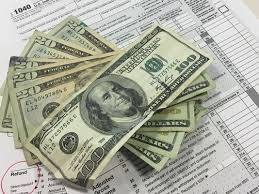
A Tax Refund occurs when you get a rebate as a result of paying excess taxes than the tax liability owed by you. That is, you will get a refund when the Tax authorities discover that you pay more than the tax liability you owe for the tax period. However, you have a few options to choose from in situations like this; you can either request to receive your refund in cash or apply your tax refund to next year’s estimated taxes.
One of the benefits of applying your refund to next year’s taxes is that the refund amount will apply to the first estimated payment until the entire return has been exhausted. Another benefit is that it can help ease you the burden of setting aside money to pay your estimated taxes.
On the plus side, applying for a tax refund to next years estimated taxes is pretty simple, all you need do is to follow the basic and easy-to-follow instructions [which we shall show you later in this article].
You may consider applying all or a fraction of your current tax returns to your return next year if:
1. Your refund is small. If the amount involved in the refund is pretty low, you may choose to apply the entire amount to the following year’s tax return to bring about more convenience.
2. Your refund is more significant than average. If the amount allocated to you as a refund is relatively large than usual, you may choose to apply the entire amount or part of it to the following year’s taxes, particularly if you are looking forward to a higher tax liability in a few years to come
3. Deadline is close by, and you pay estimated taxes. If the period [April 15] is almost in, you may choose to apply the entire amount or part of it to your first quarter estimated tax payment. By so doing, you will be able to prevent yourself against or reduce underpayment penalties that may occur in the future
Please Note: Once you decide with the Tax authorities to have your refund applied to your next year's estimated tax amount, you can no longer change your mind and have the funds rebated to you after the deadline, which is April 15th.
As earlier said, you can apply all of your overpayment or part of it to your next year’s taxes. Once the selected year is over, the amount applied then will show up as a credit, and thus reducing your taxes for that year. So, how can you add your refund to next year’s taxes? Follow these simple steps:
Step 1: Open your return, if you are yet to open it.
Step 2: Now, inside the return, you just opened, search for this exact phrase “apply the federal refund to next year” and from the search results displayed to you select the Jump to a link
Step 3: Finally, follow the instructions on the Get Your Refund Now or Apply It to Next Year's Taxes screen (online versions) or Apply Refund to 2018 Taxes (CD/download versions).
Step 1: Open your return, if you are yet to open it.
Step 2: Look at the upper-left side of the screen and Tap the menu icon
Step 3: Under the Federal Taxes option tap “Other Tax Situations.”
Step 4: Then, tap on Additional Tax Payments, and Apply Refund to Next Year.
Step 5: Now, you will be prompted on how you want us to handle your 2018 refund, select the first option (apply all or part of it) swipe right to proceed.
Step 6: Enter the total amount you want to apply and continue.
Tip: If you are paying quarterly estimated taxes, it is recommended you apply a part of your overpayment to the following year’s first-quarter estimated tax payment, which the deadline is April 15. By so doing, you will be able to prevent yourself against underpayment penalties that may occur on next year's return.
